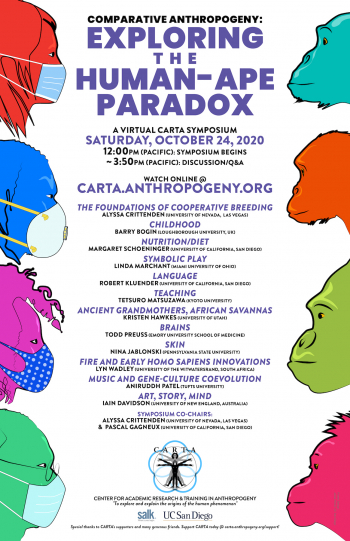Comparative Anthropogeny: Exploring The Human-Ape Paradox
Pascal Gagneux, UC San Diego
Alyssa Crittenden, University of Nevada, Las Vegas
Summary:
CARTA’s Fall 2020 symposium, Comparative Anthropogeny: Exploring the Human Ape-Paradox, examines humans as a uniquely evolved, "biologically enculturated," species as juxtaposed with our closest living relatives, the "great apes" (chimpanzees, bonobos, gorillas, and orangutans). By definition, each species is unique as it represents the outcome of independent evolution. Yet, humans appear to be a remarkable outlier as we have numerous characteristics so far un-described in any other primate. Why should this be? Unlike other species, the evident animal nature of humans is interwoven with a distinctly human cultural fabric, forming the paradox of "biological enculturation": a species that is both "biologically cultural" and "culturally biological". In humans, "biological enculturation" is so pervasive that disentangling the cultural and biological components is impossible.
This symposium will address several important distinctly human "biologically enculturated" characteristics, both in relation to each other and in contrast to our evolutionary cousins. Goals include transdisciplinary interactions, improved self-understanding, promotion of ethically sound studies to explain known differences, and the generation of new, potentially unexplored, insights on uniquely-human specializations. Given the interest in understanding our evolution, this symposium will also help to organize how and in what sequence distinctly human physical, mental, social, and cultural features evolved. Such understanding may help explain the origin of our species and how it came to now directly shape the planet, giving rise to the Anthropocene (a proposed geological epoch distinguished by human influence on climate and the environment).
The CompAnth series gathers dedicated CARTA Members and MOCA entry editors for discussions regarding humans and our closest evolutionary cousins (chimpanzees, bonobos, gorillas and orangutans i.e, "great apes"), with an emphasis on uniquely human features. These insights form the foundation for CARTA's "Matrix of Comparative Anthropogeny" (MOCA)" online resource and planned ebook entitled, "Comparative Anthropogeny (CompAnth)."
Initial funding for the MOCA/CompAnth project and for this public symposium was generously provided by late CARTA Major Sponsor Annette Merle-Smith.
Media for each talk can be played by clicking on icons in the table below, or by clicking on the individual talk titles below and then the attachment file at the bottom of the page.
| Speakers | Media | Session |
|---|---|---|
 Ajit Varki |
|
Introduction |
 Pascal Gagneux |
|
The Matrix of Comparative Anthropogeny |
 Alyssa Crittenden |
|
The Foundations of Cooperative Breeding Alloparenting, or the investment in young by individuals other than the biological parents, occurs among a wide array of insects, birds, and mammals – including humans. Human reproduction is characterized by notable features that distinguish it from the general mammalian pattern and that of apes, our closest living relatives. Comparatively, we wean our infants early, before they are nutritionally independent. Despite this practice of early weaning, we maintain relatively short inter-birth... read more |
 Barry Bogin |
|
Childhood In this presentation we try to understand why people grow-up in such a strange way, taking over twenty years to reach fully productive and reproductive adulthood, but even as adults remain connected and interdependent with so many other people. As part of CARTA I focus on one human-ape paradox – the uniquely human stage of childhood development. Human childhood takes place between the ages of about 3 to 7 years. The evolution of childhood was good for the mother as it freed her from breast-... read more |
 Margaret Schoeninger |
|
Food for Thought: Nutrition & Diet Over the last 10 years, the fascination for identifying the ‘Natural Human Diet’ has expanded beyond anything imagined by Eaton and Konner who authored the first paper on Paleolithic Nutrition. The publication of Paleodiet and Paleonutrition cookbooks has exploded, almost exponentially although the science underlying these diets is not always very convincing. Over the same period, we have seen another explosion in the scientific literature on the diets of some fossil members of our lineage... read more |
 Linda Marchant |
|
Symbolic Play Symbolic (also labeled fantasy, imaginative or pretend) play is a human universal. Its role in ontogeny, especially childhood, is essential to cognitive and social development. A child’s capacity to utilize objects, actions or ideas in symbolic play scaffolds cognitive flexibility/ creativity, tempers emotional regulation, and may impact language development. This presentation explores whether our nearest living relatives, the great apes (chimpanzee, bonobo, gorilla, and orangutan) evince a... read more |
 Robert Kluender |
|
Language In the language evolution literature there is a well-known paradox: human language appears very different from animal communication, but has to have come from somewhere evolutionarily. Since previously existing hominin species have all gone extinct, it’s nearly impossible to use them as a basis of comparison. Aside from fossilized bones, all that’s left to us are currently existing animal species. And at first blush their communication abilities – and those of other great apes – seem quite... read more |
 Tetsuro Matsuzawa |
|
Teaching: Education by Master-Apprenticeship in Chimpanzees I have been studying chimpanzees in the wild (Bosou-Nimba, Guinea, West Africa) and also in the laboratory (the Primate Research Institute of Kyoto University). In short, “Teaching” in chimpanzees is called “Education by master-apprenticeship”. In my talk, I will introduce the three topics: 1) the mother-infant relationship in chimpanzees, 2) tool-use in the wild, and 3) the laboratory simulation of “Education by master-apprenticeship”. At the last point, I want to introduce 4) the extra-... read more |
 Kristen Hawkes |
|
Ancient Grandmothers, African Savannas Human life history evolved from an ancestral condition shared with the other great apes whose infants begin to feed themselves on the fruits and leaves their mothers are eating while still nursing, then feed on their own at weaning so mothers can commit to their next offspring. The savannas that spread in ancient Africa would have presented foraging opportunities with novel tradeoffs. Lessons come from modern people foraging in African savannas now. Hadza women earn predictable returns from... read more |
 Todd Preuss |
|
Brains Advances in noninvasive neuroimaging and comparative genomics over the past two decades have yielded a remarkable body of new knowledge about the differences in brain organization between humans, apes, and other primates. Although human specializations have been identified in many different brain systems, modifications of the classical association cortical regions—the prefrontal cortex, posterior parietal cortex, and the middle and inferior temporal cortex—are especially pertinent to the... read more |
 Nina Jablonski |
|
Skin Mostly naked, potentially sweaty, and variably colored skin is a hallmark of modern human beings. Skin is often overlooked in discussions of human evolution because it is rarely preserved in the fossil record. But because of its central role as an interface between the outside world and the body, it is essential that we study the evolution of skin and, specifically, how our skin differs from that of our ape relatives. We evolved mostly naked skin early in the evolution of the genus Homo for... read more |
 Lyn Wadley |
|
Fire and Early Homo Sapiens Innovations Fire, more than any other technology, separates human from non-human primate behavior. Fire was used expediently by pre-Homo sapiens hominins more than a million years ago. Rare, ephemeral traces of early fire use have been recovered from archaeological sites in Africa, Israel and Europe. Perhaps the ability to cook food occasionally, thereby extracting nutrients easily, played some role in hominin evolution, allowing the development of smaller teeth and gut, and larger, more nutrient-costly... read more |
 Aniruddh Patel |
|
Music and Gene-Culture Coevolution Have humans evolved neural specializations for music processing, or is music a purely cultural invention based on brain circuits that evolved for other reasons, like literacy? This debate, which goes back to Darwin’s writings on music in The Descent of Man, is far from resolved. While the debate is often framed as a dichotomy between biological vs. cultural views of music’s origins, a new line of thinking is emerging which considers musicality in the framework of gene-culture coevolution. In... read more |
 Iain Davidson |
|
Art, Story, Mind The role of art in anthropogeny cannot be understood by using concepts from modern students of art, since art theory and art philosophy have moved a long way from anything that led to them. Our goal is to understand how those modern concepts arose in hominin and human evolution. To investigate this, first, we need a definition of art which will encompass early examples and yet lead us to a definition we can recognise. Art is about a material intervention in relationships between people and the... read more |
 All Speakers |
|
Questions, Answers & Discussion |
Event Glossary
A glossary for this event is available as a Searchable List and a ![]() PDF.
PDF.
| Attachment | Size |
|---|---|
| 530.02 KB | |
| 808.15 KB |
If you enjoy this event, please consider supporting CARTA's quest to explore and explain the human phenomenon.



